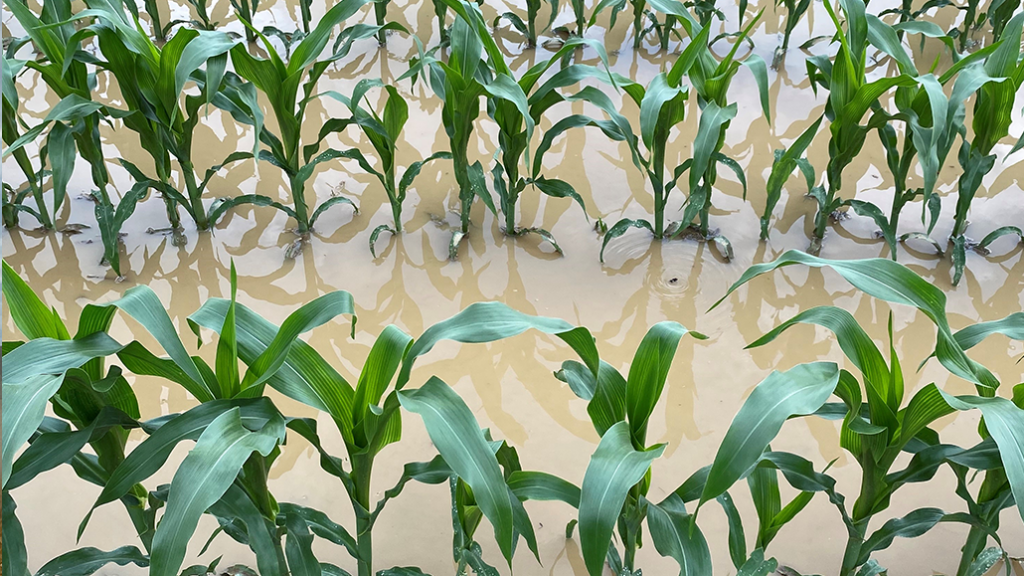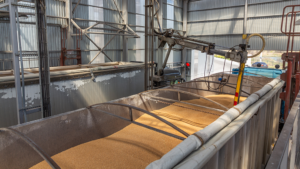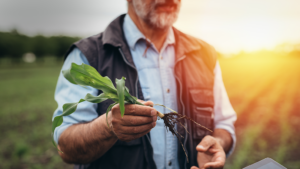A year in review
GRAIN FARMERS OF ONTARIO AGRONOMIST WEIGHS IN

LIKE MOST YEARS, it has been a year of ups and downs: temperature, moisture, and, in some cases, disease.
Heavy rains and snow across much of the province at the start of spring caused a slight delay in planting. Some had taken a risk and planted in a warm stretch of weather in April, while more held out until May rolled around. Whether fields were planted in either month, some farmers had a humbling experience (myself included) when soybean replants happened due to a particularly cold week in May, which affected emergence. Overall, conditions were cool, and emergence for all crops this spring was on the slow side of things; in fact, much of the growing season was behind the historical average for crop heat units (CHUs) due to cool conditions, smoke-filled skies, or as many experienced in August, a rain tap that just would not shut off, and with it very cloudy skies.
As mid to late spring rolled around, crop progress was very staggered, with some crops just getting planted and others progressing well. There was also a great concern about when the next rainfall would arrive; when conditions finally allowed for acres to be planted, there was little moisture in the forecast, and it remained this way for several weeks.
WINTER CEREALS
Winter cereals in the fall of 2022 were planted in amazing conditions and, with an open fall, had great growth before winter set in. They looked exceptional at the start of spring, but as the year stretched towards summer, there was some concern over heat stress during the flowering period. Low moisture also helped ease fears of fusarium infection. After flowering, the weather turned cooler, allowing for an extended grain fill period. Many reported exceptional yields, with many past yield records broken.
As summer arrived, there were timely rains, which helped the crops progress. However, those timely rains turned into rain that would not stop! Some areas received numerous inches daily, causing waterlogged soils, root rots, and disease. And at the same time, other areas were screaming for rain.
WATERLOGGED SOILS
Soybeans were impacted by phytophthora root rot on heavier and waterlogged soils. Extended moisture over the flowering period also led to occurrences of white mould in fields. Fungicides were sprayed across many acres to protect the crop, but with so much moisture, it was difficult to protect the entire flowering period. Some did apply a second pass of fungicide; however, only limited acres.
Due to the early June drought and then excessive rains, stress in the corn appeared as uneven fields that showed soil structure variability. Regions with continual rainfall had ideal conditions for disease development with the excessive leaf wetness and humidity this season. Grey leaf spot, northern corn leaf blight and tar spot began showing up in mid-July. Fungicide applications around pollination were sprayed on some acres to protect plant health. Fungicides were targeting leaf disease, as well as ear rots. Large hail also caused disease concerns.
Pollination, overall, was good, leading to what many hope will be an exceptional corn crop.
Spring cereals were harvested late summer into the fall, with many reports of very good yields.
FALL OBSERVATIONS
At the time of writing, sitting here on a 21 °C evening on our porch, listening to our combine run (the kids are in bed, so I am not in the hot seat), I have great respect for those who work in acres and not hours. Yields for soybeans so far have been average to above average, with moisture in the low to mid-teens, some reaching down into the single digits as this unusual warmth has dried down the crop very quickly. Winter wheat is being seeded as fast as it can be. It has been a late soybean harvest, approximately one to two weeks delay from normal, due to the previously mentioned slower CHU accumulation throughout the year. But, the weather has allowed for one of the warmest starts to October in history and helped move the crops along. And, with any luck, it will give the 2024 wheat crop a good start.
At the end of October, corn was at black layer or close to black layer for most locations. Fungicides seem to be doing their job, limiting tar spot and other diseases; however, areas close to the lower Great Lakes have been impacted especially by tar spot, with plants shutting down well before normal. Ear moulds and stalk rots are starting to cause concerns in the field, as is the potential for deoxynivalenol (DON).
Looking at the long-range forecast, harvest of the remaining soybeans and into corn harvest might be a challenge with lots of moisture, both from the skies and in the harvestable crop.
With high winter wheat and spring cereal yields and what looks to be bumper crops for soybeans and corn, the prediction is that grain bin space will be short this year.
As we head into 2024, some topics to keep in mind: be on the lookout for disease, pests, and new or troublesome weed species in the region and be prepared to manage the crop for new or existing threats, mitigate off-target movement of herbicides, and as always, stay safe.
Laura Ferrier is a Certified Crop Advisor and Grain Farmers of Ontario’s agronomist. Read Ferrier’s Field Observations in Grain Farmers of Ontario’s weekly GrainTALK e-newsletter or at www.OntarioGrainFarmer.ca during the growing season, and follow her on Twitter/X at @AustinELaura. •
























